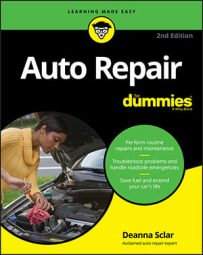When you perform repairs, you need a procedure that helps you take things apart and get them back together. The procedure here works for repairs that require you to take something apart and put back together again — flat tires, toasters, bicycles, you name it.
Allow yourself plenty of time. If things get rough, have some water or a cup of coffee. You may get a whole new perspective when you go back to work. Limit distractions: Turn on your answering machine or take the phone off the hook, keep the kids and the dog away, and relax. If you hit a snag, sit quietly and think about it — don’t panic. If the parts fit together before, they’ll fit together again.
Follow these instructions, breathing slowly and deeply:-
Lay a clean, lint-free rag down on a flat surface, near enough to reach without having to get up or walk to it.
You’ll lay each part on this rag as you remove it. Consequently, the rag shouldn’t be in an area where oil or dust or anything else can fall on it and foul up the parts. If you plan to use something that blasts air for cleaning purposes, leave enough of the rag uncluttered to fold it over the parts resting on it.
-
As you remove each part, note (on paper, so you won't forget) where the part came from, how it was attached, and how tightly it was fastened or screwed down.
Most amateurs put things back very tightly, in hopes that the part won’t fly off. But some things, like bolts that hold gaskets in place, shouldn’t be tightened too securely because, for example, the bolt threads could be stripped or the gasket could be squeezed out of shape, allowing whatever it’s holding in to get out. It’s helpful to make notes about how hard each thing was to remove. “Don’t over-tighten” or “Be sure it’s secure.”
-
As you remove each part, lay it down on the rag in clockwise order, with each part pointing in the direction it was in before you removed it.
This is the key to the whole system. When you’re ready to reassemble things, the placement and direction of each part tells you when to put it back and how it was oriented.
-
If you’re making notes, assign each part a number indicating the order in which you removed it — Part #1, Part #2, and so on.
You can even put numbers on the parts with masking tape if you’re afraid that the rag may be moved accidentally. Also, note what each part was attached to; for example, “Part #6: Hook at end of arm on left hooks onto knob to right of Part #7.” Add a sketch if it helps.
If you work systematically and understand the function of each part, you won’t be left with what seem to be extra nuts and bolts at the end of the job.
-
When you’re ready to reassemble everything, begin with the last part you removed, and proceed counterclockwise through the parts on the rag.
If you’ve numbered the parts, they should go on in reverse order.

